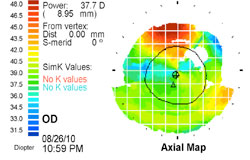Cataract with Salzmann’s nodular degeneration poses unique challenge
Case presentation: A 61-year-old patient presented with a history of cataract in both eyes, reducing vision to 20/60 OD and 20/50 OS. The exam revealed white discrete nodules on the anterior corneal surface causing negative fluorescein staining. There was moderate nuclear and cortical cataract as well. Her exam was otherwise unremarkable.
Work-up: Corneal topography revealed irregular astigmatism in both eyes and areas of data dropout (white areas) on topography because of an irregular corneal surface.
This patient has the unique challenge of cataract in combination with Salzmann’s nodular degeneration of the cornea. The latter is frequently associated with dry eye and causes irregularity in the corneal surface that reduces best corrected visual acuity.

Salzmann's nodular degeneration can cause irregular astigmatism that, unless treated first, can decrease best corrected vision after cataract surgery.
Image: Hovanesian JA
Take-home points: Before recommending cataract surgery, it is necessary to identify other sources of visual disturbance, such as corneal Salzmann’s nodular degeneration, and address these if possible. Counseling patients about these comorbidities will appropriately set their expectations that more than one procedure may be necessary and that their ultimate vision may not be comparable to that of their friends who have gone through cataract surgery.
Salzmann’s nodular degeneration of the cornea may present with subtle and peripheral abnormalities on the cornea, but these can significantly alter the outcome of cataract surgery. They are fairly easily treated, yielding a corneal surface that allows for a much more normal outcome. Despite complete removal of Salzmann’s nodules, corneas may retain some irregularity that may reduce contrast. This would limit the success with a multifocal lens implant but would not obviate the use of an accommodating lens implant such as the Crystalens.
For more information:
- Richard A. Kidder, OD, FAAO, contributed to this column
- Disclosures: Dr. Hovanesian is a consultant to Bausch + Lomb. Dr. Kidder has no relevant financial disclosures.
